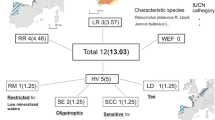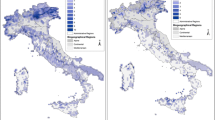Abstract
The IUCN Red List of threatened species is recognised as the accepted standard for species global extinction risk worldwide, and the criteria led down for evaluation are considered as one of the best methods to evaluate extinction risk of species at the global and regional levels.The IUCN’s Red List categories are given more emphasis in determining the conservation status of species and for prioritizing conservation strategies upon these threatened species. The guidelines for evaluation are laid down comprehensively to minimize errors and to maintain consistency of Red List assessments across taxa. However in some cases, it seems that the assessments based on current IUCN criteria do not accurately reflect the real extinction risk of some taxonomic groups. This is not owing to the quality or quantity of the data produced, but rather to some methodological artifacts that affects certain groups of taxa. In this paper we discuss such an event considering an aquatic plant group; genus Aponogeton; from Sri Lanka. All the known Sri Lankan Aponogeton species have been evaluated under the Criteria B adhering to the given IUCN guidelines and the results suggest that such smaller aquatic plants with high habitat specificity are at a disadvantage when securing their conservation statuses, and thereby lose the protection they deserve through legislations. This study emphasises the obligation of much comprehensive evaluation criteria to estimate the AOO in different plant categories.


Similar content being viewed by others
References
Abeli T, Gentili R, Rossi G, Bedini G, Bruno F (2009) Can the IUCN criteria be effectively applied to peripheral isolated plant populations. Biodivers Conserv 18:3877–3890. https://doi.org/10.1007/s10531-009-9685-4
Ashton MS, Gunatilleke S, de Zoysa N, Dassanayake MD, Gunatilleke N, Wijesundera S (1997) A field guide to the common trees and shrubs of Sri Lanka. Wildlife heritage trust publications (pvt.) Limited, Colombo
De Grammont PC, Cuarón AD (2006) An evaluation of threatened species categorization systems used on the American continent. Conserv Biol 20:14–27. https://doi.org/10.1111/j.1523-1739.2006.00352.x
De Silva MA, Deshaprema KMS, Manamperi JPJ (2016) Aponogetonkannangarae, a new species of Aponogeton (Aponogetonaceae) from Rakwana hills, Sri Lanka. Phytotaxa 272(2):220–224
ESRI (2017) ArcGIS Desktop: Release 10.4. Environmental Systems Research Institute, Redlands
Gunawardana J (2005) Kekatiya; the untold story. The Island newspaper. http://cea.nsf.ac.lk/handle/1/14564. Accessed 29 March 2019
IUCN (2001) IUCN Red List Categories and Criteria: Version 3.1. IUCN Species Survival Commission. IUCN, Gland
IUCN (2012) IUCN Red List Categories and Criteria: Version 3.1, 2nd edn. IUCN, Gland
IUCN (2017) Guidelines for Using the IUCN Red List Categories and Criteria. Version 13. Prepared by the Standards and petitions. IUCN, Gland
Keith AD (1998) An evaluation and modification of World Conservation Union Red List Criteria for classification of extinction risk in vascular plants. Conserv Biol 12:1076–1090
Kotagama S, Bambaradeniya C (2006) an overview of the wetlands of Sri Lanka and their conservation significance. In: National Wetland Directory of Sri Lanka. IUCN Sri Lanka and the Central Environmental Authority, Colombo, Sri Lanka
Mace GM, Collar NJ, Gaston KJ, Hilton-Taylor C, Akakaya HR, Leader-Williams N, Milner-Gulland EJ, Stuart SN (2008) Quantification of extinction risk: IUCN’s system for classifying threatened species. Conserv Biol 22:1424–1442
Manawaduge CG, Yakandawala D (2018) Morphometrics and taxonomic update to the Sri Lankan Aponogetonaceae. Phytotaxa 365(3):201–224
Manawaduge CG, Yakandawala D, Les DH (2016) Morphometric analysis reveals a new species of Aponogeton (Aponogetonaceae) in Sri Lanka. Phytotaxa 275(3):243–262
Mittermeier RA, Turner WR, Larsen FW, Brooks TM, Gascon C (2011) Global biodiversity conservation: the critical role of hotspots. In: Zachos F, Habel J (eds) Biodiversity Hotspots. Springer, Berlin, pp 3–7
MOE (2012) The National Red List 2012 of Sri Lanka; conservation status of the fauna and flora. Ministry of Environment, Colombo
Parsons ECM (2016) Why IUCN should replace “Data Deficient” conservation status with a precautionary “Assume Threatened” status—a cetacean case study. Front Mar Sci 3:193. https://doi.org/10.3389/fmars.2016.00193
Petitions Subcommittee. Downloadable from http://www.iucnredlist.org/documents/RedListGuidelines.pdf
Rodrigues ASL, Pilgrim JD, Lamoreux JF, Hoffmann M, Brooks TM (2006) The value of the IUCN Red List for conservation. Trends Ecol Evol 21(2):71–76
van Bruggen HWE (1985) Monograph of the genus Aponogeton (Aponogetonaceae). Bibl Bot 137:14–26
van Bruggen HWE (1987) Aponogetonaceae. In: Dassanayake MD, Fosberg FR (eds) A revised hand book to the flora of Ceylon, vol VI. Amerind Publishing, New Delhi, pp 3–16
Yakandawala D (2012) Present status of fresh water aquatic flora in Sri Lanka. In: Weerakoon DK, Wijesundara S (eds) The National Red List 2012 of Sri Lanka; Conservation Status of the Fauna and Flora. Ministry of Environment, Colombo, pp 186–196
Acknowledgements
Financial assistance provided by the University of Peradeniya, Sri Lanka (University Research Grant RG/2014/38/S to DY) is gratefully acknowledged. Authors wish to thank The Department of Wildlife Conservation of Sri Lanka for granting permission for the field visits, National Herbarium, Royal Botanical Gardens, Peradeniya and Dr. Menaka Ariyarathne and U. B. Priyadharshana for their assistance in the field. First author would also like to acknowladge her current institute; Queensland University of Technology, Queensland, Australia; and her current supervisor; Assoc. Prof. Susan Fuller.
Author information
Authors and Affiliations
Corresponding author
Additional information
Communicated by Daniel Sanchez Mata.
Publisher's Note
Springer Nature remains neutral with regard to jurisdictional claims in published maps and institutional affiliations.
This article belongs to the Topical Collection: Biodiversity protection and reserves.
Rights and permissions
About this article
Cite this article
Manawaduge, C.G., Yakandawala, D. & Yakandawala, K. Does the IUCN Red-Listing ‘Criteria B’ do justice for smaller aquatic plants? A case study from Sri Lankan Aponogetons. Biodivers Conserv 29, 115–127 (2020). https://doi.org/10.1007/s10531-019-01873-x
Received:
Revised:
Accepted:
Published:
Issue Date:
DOI: https://doi.org/10.1007/s10531-019-01873-x




